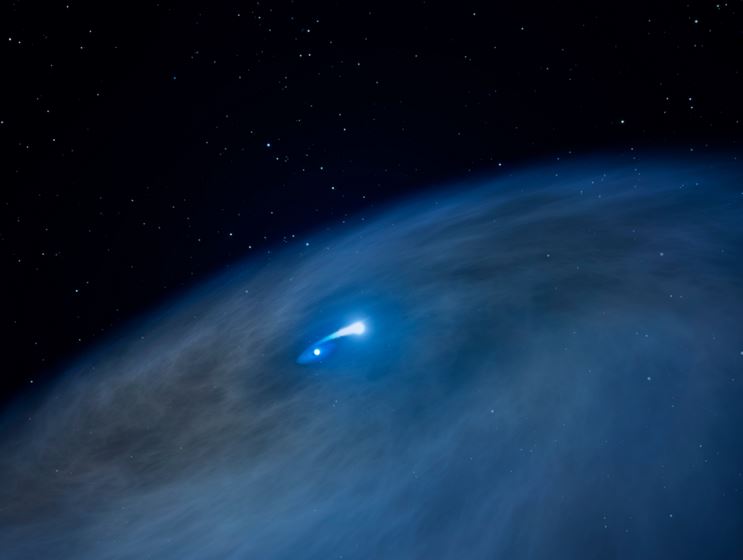There is a weird aging star about 3,000 light years away – nicknamed Nasty 1 – whose behaviour has baffled astronomers. The star, which is in our galaxy, the Milky Way, was observed using NASA’s Hubble Space Telescope.
Astronomers from the The University of Arizona, the University of California, Berkeley, IPAC/Caltech, and the Carnegie Institute of Washington, wrote about their study in the academic journal Monthly Notices of the Royal Astronomical Society.
Its nickname does not mean the star poses any danger. Its name is a play on its catalogue name NaSt1. Scientists believe it represents a brief transitory stage in the evolution of super-massive stars.

Named after those who discovered it
When discovered in 1963 by Jason Nassau and Charles Stephenson, it was identified as a Wolf-Rayet (WR) star, a fast-evolving star that is much bigger than our Sun. It loses its hydrogen-filled outer layer rapidly, exposing its ultra-hot and super-bright helium-burning core. WR stars’ surface temperatures range from 30,000°C to 200,000°C.
NaSt1 is derived from the first two letters of the surnames of Jason Nassau and Charles Stephenson.
However, this one does not look like a typical WR star. Using the Hubble, the astronomers had expected the star to have twin lobes of gas flowing from opposite sides of the star, maybe similar to those emanating from WR candidate Eta Carinae (a massive star).
Encircled by a pancake-shaped disk
Nasty 1 has a pancake-shaped disk of gas encircling it. The enormous disk is almost 2 trillion miles across, and may have formed from an unseen companion star that fed on the outer envelope of the newly-formed WR.
The scientists estimate that the nebula surrounding the stars is only a few thousand years old, and about 3,000 light from Earth.
Study leader, Jon Mauerhan, who works at the University of California, Berkeley, said:
“We were excited to see this disk-like structure because it may be evidence for a Wolf-Rayet star forming from a binary interaction.”
“There are very few examples in the galaxy of this process in action because this phase is short-lived, perhaps lasting only a hundred thousand years, while the timescale over which a resulting disk is visible could be only ten thousand years or less.”
In the researchers’ proposed scenario, a massive star evolves super-rapidly, and as it starts to run out of hydrogen it swells up. The star’s outer hydrogen envelope becomes more loosely bound and susceptible to gravitational stripping, or a kind of stellar cannibalism, by a companion star close by.
The compact companion-star ends up gaining mass in that process, and the original massive star is stripped of its hydrogen envelope, exposing its helium core to become a WR star.
WR stars can also be formed when a massive star ejects its own hydrogen envelope in a powerful stellar wind streaming with charged particles.
Most massive stars belong to binary systems
The hypothesis that a binary interaction (two stars) is involved is gaining traction, because scientists realize that at least 70% of massive stars belong to double-star systems.
Direct mass loss alone also cannot account for the number of WR stars relative to other less-evolved massive stars in the Milky Way.
Co-author, Nathan Smith, of the University of Arizona in Tucson, said:
“We’re finding that it is hard to form all the Wolf-Rayet stars we observe by the traditional wind mechanism, because mass loss isn’t as strong as we used to think.”
“Mass exchange in binary systems seems to be vital to account for Wolf-Rayet stars and the supernovae they make, and catching binary stars in this short-lived phase will help us understand this process.”
However, the mass transfer process in mammoth two-star systems is not always efficient. Some of the matter that is stripped can spill out during the gravitational tug-of-war between the two stars, creating a disk around the binary.
Mauerhan said:
“That’s what we think is happening in Nasty 1. We think there is a Wolf-Rayet star buried inside the nebula, and we think the nebula is being created by this mass-transfer process. So this type of sloppy stellar cannibalism actually makes Nasty 1 a rather fitting nickname.”
Difficult to observe Nasty 1 properly
Observing the Nasty 1 system has been challenging, given the heavy gas and dust cloaking around it. The team says it is unable to measure the mass of each star, how far away they are from each other, or how much material is spilling onto the companion star.
Previous observations have provided some data on the gas in the disk around Nasty 1. In the outer nebula, the material is travelling at about 22,000 mph, which is slower than in similar stars.
Its slower speed suggests that the star expelled its material through a less violent event than the explosive outbursts that occurred with Eta Carinae, where the gas is moving at hundreds of thousands of miles per hour.
Nast 1 may also be shedding the material intermittently. Previous studies using infrared light have shown evidence for a compact pocket of dust extremely near to the central stars.
Recent observation by Mauerhan and team, using the Magellan telescope at the Chilean Las Campanas Observatory, have resolved a larger pocket of cooler dust that may be indirectly scattering the light from the central stars.
The presence of warm dust suggest that it formed very recently, maybe in spurts, as chemically-enriched material from the two stellar winds collides at different points, mixes, flows away, and cools down.
Intermittent changes in wind speed, or the rate the companion strips the main star’s hydrogen envelope, could also explain the chunky structure and gaps observed farther out in the disk.
The team used NASA’s Chandra X-ray Observatory to measure the hypersonic winds from each star. The observations revealed scorching-hot plasma, suggesting that the winds from both stars are colliding, creating high-energy shocks that glow in X-rays.
These results tally with what scientists have observed from other WR systems.
The chaotic mass-transfer activity will cease when the WR star runs out of material. The gas in the disk will eventually dissipate, making it easier to observe the binary system.
Mauerhan said:
“What evolutionary path the star will take is uncertain, but it will definitely not be boring. Nasty 1 could evolve into another Eta Carinae-type system.”
“To make that transformation, the mass-gaining companion star could experience a giant eruption because of some instability related to the acquiring of matter from the newly formed Wolf-Rayet. Or, the Wolf-Rayet could explode as a supernova.”
“A stellar merger is another potential outcome, depending on the orbital evolution of the system. The future could be full of all kinds of exotic possibilities depending on whether it blows up or how long the mass transfer occurs, and how long it lives after the mass transfer ceases.”
Citation: “Multiwavelength observations of NaSt1 (WR 122): equatorial mass loss and X-rays from an interacting Wolf–Rayet binary,” Jon Mauerhan, Nathan Smith, Schuyler D. Van Dyk, Katie M. Morzinski, Laird M. Close, Philip M. Hinz, Jared R. Males, and Timothy J. Rodigas. Monthly Notices of the Royal Astronomical Society. Published 20 May, 2015. DOI: 10.1093/mnras/stv257.

